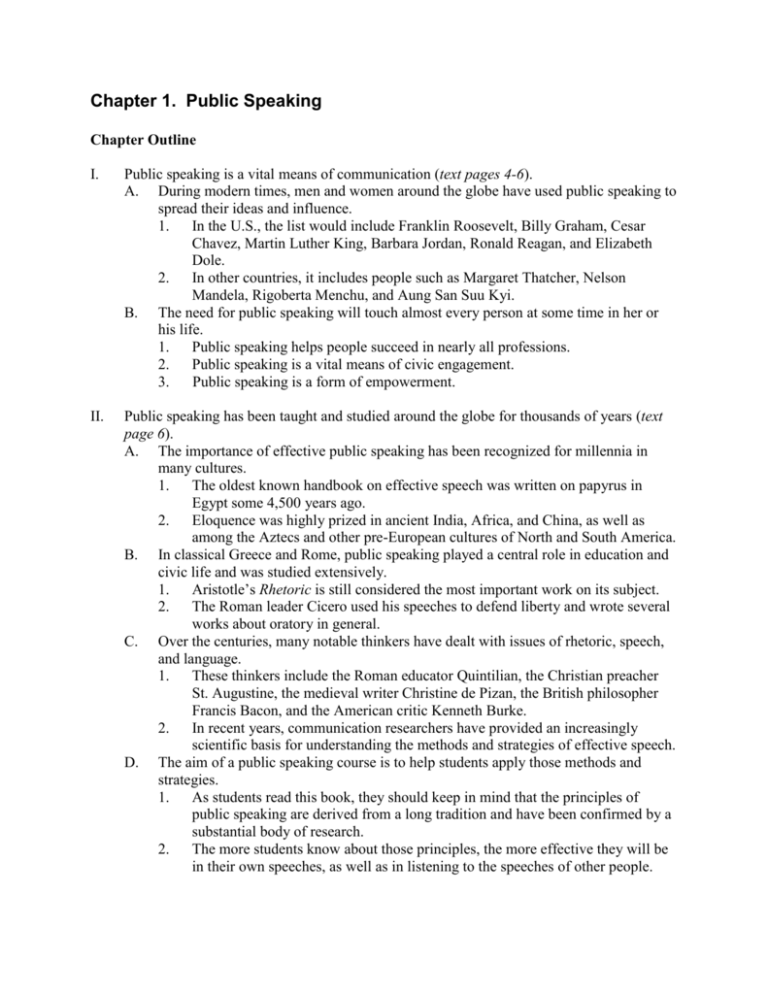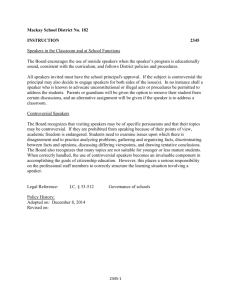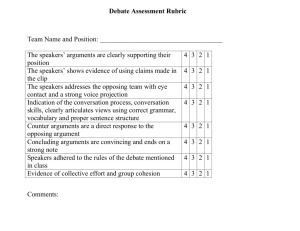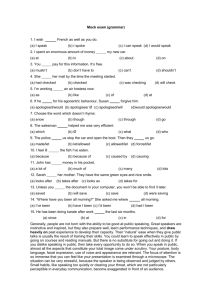Introductory lecture
advertisement

Chapter 1. Public Speaking Chapter Outline I. Public speaking is a vital means of communication (text pages 4-6). A. During modern times, men and women around the globe have used public speaking to spread their ideas and influence. 1. In the U.S., the list would include Franklin Roosevelt, Billy Graham, Cesar Chavez, Martin Luther King, Barbara Jordan, Ronald Reagan, and Elizabeth Dole. 2. In other countries, it includes people such as Margaret Thatcher, Nelson Mandela, Rigoberta Menchu, and Aung San Suu Kyi. B. The need for public speaking will touch almost every person at some time in her or his life. 1. Public speaking helps people succeed in nearly all professions. 2. Public speaking is a vital means of civic engagement. 3. Public speaking is a form of empowerment. II. Public speaking has been taught and studied around the globe for thousands of years (text page 6). A. The importance of effective public speaking has been recognized for millennia in many cultures. 1. The oldest known handbook on effective speech was written on papyrus in Egypt some 4,500 years ago. 2. Eloquence was highly prized in ancient India, Africa, and China, as well as among the Aztecs and other pre-European cultures of North and South America. B. In classical Greece and Rome, public speaking played a central role in education and civic life and was studied extensively. 1. Aristotle’s Rhetoric is still considered the most important work on its subject. 2. The Roman leader Cicero used his speeches to defend liberty and wrote several works about oratory in general. C. Over the centuries, many notable thinkers have dealt with issues of rhetoric, speech, and language. 1. These thinkers include the Roman educator Quintilian, the Christian preacher St. Augustine, the medieval writer Christine de Pizan, the British philosopher Francis Bacon, and the American critic Kenneth Burke. 2. In recent years, communication researchers have provided an increasingly scientific basis for understanding the methods and strategies of effective speech. D. The aim of a public speaking course is to help students apply those methods and strategies. 1. As students read this book, they should keep in mind that the principles of public speaking are derived from a long tradition and have been confirmed by a substantial body of research. 2. The more students know about those principles, the more effective they will be in their own speeches, as well as in listening to the speeches of other people. III. Public speaking and everyday conversation have a number of similarities and require similar skills (text pages 6-8). A. In both, people organize their thoughts logically. B. In both, people tailor their message to the audience. C. In both, people tell a story for maximum impact. D. In both, people adapt to feedback from listeners. IV. There are three key differences between public speaking and everyday conversation (text page 9). A. Public speaking is more highly structured than ordinary conversation. 1. There are usually time limits on the length of a speech. 2. In most situations listeners do not interrupt a public speaker to voice questions or comments. B. Public speaking requires more formal language than ordinary conversation. 1. Listeners usually react negatively to slang, jargon, and bad grammar in public speeches. 2. Because a public speech is supposed to be “special,” most successful speakers elevate and polish their language when addressing an audience. C. Public speaking requires a different method of delivery from ordinary conversation. 1. When conversing informally, most people talk quietly, interject stock phrases such “you know,” “like,” and “really,” adopt a casual posture, and the like. 2. Effective public speakers adopt a more formal manner of delivery and avoid distracting mannerisms and verbal habits. D. With study and practice, most people are able to master these differences and expand their conversational skills into speechmaking. V. One of the major concerns of students in any speech class is stage fright (text pages 916). A. It is entirely normal to feel nervous about the prospect of giving a public speech. B. Even experienced public speakers have stage fright before their presentations. C. There are six major steps students can take to control their nervousness and make it a positive force in their speeches. 1. One is to take a speech class in which they will learn about speechmaking and gain speaking experience. 2. Another is to be thoroughly prepared for every speech they present. a. It is difficult to be confident of success when one stands up to speak without knowing what to say or how to say it. b. Most people find that their confidence increases dramatically when they practice a speech until they have full command of the ideas and the delivery. 3. It is also crucial that speakers think positively about themselves and the speech experience. a. Confidence is largely the well-known power of positive thinking. b. Speakers who think negatively about themselves and the speech experience are much more likely to be overcome by stage fright than are speakers who think positively. c. D. For each negative thought about their speeches, students should counter with at least five positive ones. 4. Using the power of visualization is another excellent way to combat stage fright. a. Visualization is used by athletes, musicians, actors, speakers, and others to enhance their performance in stressful situations. b. The key to visualization is creating a mental blueprint in which one presents a successful speech. 5. Most speakers are also helped by knowing that their nervousness is usually not visible to the audience. 6. It is also important not to expect perfection when delivering a speech. a. Even accomplished speakers make mistakes, but most of the time no one besides the speaker notices. b. Speechmaking should be seen as an act of communication rather than as a kind of performance in which absolute perfection is required. c. Speech audiences are not looking for a virtuoso performance, but for a well-thought-out address that communicates the speaker’s ideas clearly and directly. In addition, there are a number of specific tips that can help students deal with nervousness. 1. Be at your physical and mental best when speaking. 2. Quietly tighten and relax hand or leg muscles while waiting to speak. 3. Take a few slow, deep breaths before starting to speak. 4. Work especially hard on your introduction. 5. Make eye contact with people in the audience. 6. Concentrate on communicating with the audience rather than on worrying about your nervousness. 7. Use visual aids to help occupy the attention of the audience. VI. Public speaking helps people develop critical thinking skills (text pages 16-17). A. Critical thinking involves a number of skills. 1. Critical thinking involves being able to assess the strengths and weaknesses of an argument. 2. Critical thinking involves distinguishing fact from opinion. 3. Critical thinking involves judging the credibility of sources. 4. Critical thinking involves assessing the quality of evidence. 5. Critical thinking involves discerning the relationships among ideas. B. These—and other—critical thinking skills are enriched by a public speaking class. 1. As students organize their speeches, their ideas will become more clear and cohesive. 2. As students work on expressing their ideas accurately, their thinking will become more precise. 3. As students learn about the role of reasoning and evidence in speeches, they will become better able to assess reasoning and evidence in all types of situations. VII. There are seven elements of the speech communication process (text pages 17-22). A. B. C. D. E. F. G. Speech communication begins with a speaker. 1. The speaker is the person who presents the message. 2. Successful speakers combine technical skill with personal enthusiasm. The message is whatever a speaker communicates to someone else. 1. The goal of a speaker is to have the intended message be the message that is actually communicated. 2. Achieving this depends both on what the speaker says (the verbal message) and how the speaker says it (the nonverbal message). The channel is the means by which a message is communicated. 1. Public speakers may use one or more of several channels—microphone, radio, television, etc. 2. In speech class, the channel is the most direct because listeners see and hear the speaker without any media or electronic intervention. The listener is the person who receives the communicated message. 1. Everything a speaker says is filtered through a listener’s frame of reference. a. A listener’s frame of reference is the sum total of his or her knowledge, experience, goals, values, and attitudes. b. Because a speaker and listener are different people, they can never have exactly the same frame of reference. 2. Because people have different frames of reference, a public speaker must take care to adapt the message to the particular audience being addressed. Feedback consists of messages sent from the listener to the speaker. 1. Most communication situations involve two-way communication, in which the speaker can see how the audience is responding. 2. Successful public speakers learn to interpret the feedback sent by listeners and to adjust their messages in response to the feedback. Interference is anything that impedes the communication of a message. 1. Interference can be either external or internal. a. External interference comes from outside the audience—such as a ringing telephone, the noise of traffic, or static in a microphone. b. Internal interference comes from within the audience—such as poor listening skills or lack of concentration. 2. Successful public speakers work to hold their listeners’ attention despite interference. The situation is the time and place in which speech communication occurs. 1. Speech communication always takes place in a particular situation. a. A conversation might occur over a candlelight dinner or in a noisy tavern. b. A public speech might be presented in a small classroom, in a large auditorium, or at outdoor graduation ceremonies. 2. Successful public speakers are alert to the situation and adjust their remarks to it. VIII. Public speakers need to be aware of and responsive to today’s multicultural world (text pages 22-27). A. The United States has become the most diverse society on the face of the earth. 1. For more than a century, European immigrants and African Americans made the U.S. the “melting pot” of the world. 2. Today another great wave of immigration—mostly from Asia and Latin America—is making the U.S. a multicultural society of unparalleled diversity. B. Cultural diversity is more than a U.S. phenomenon. 1. We are living in an age of international multiculturalism. 2. Air travel, immigration, and electronic communication are making all nations and cultures part of a vast “global village.” C. Diversity and multiculturalism are such basic facts of life in today’s world that they affect many public speaking situations. 1. Because of the growing diversity of modern life, audiences often include people of different cultural, racial, and ethnic backgrounds. 2. Speechmaking becomes more complex as cultural diversity increases. 3. To be successful, public speakers need to take account of cultural differences between themselves and their listeners. D. It is especially important for public speakers to avoid ethnocentrism. 1. Ethnocentrism is the belief that one’s own culture or group is superior to all others. a. Ethnocentrism can play a positive role in creating group pride and loyalty. b. Ethnocentrism can be destructive when it leads to prejudice and hostility. 2. Speakers can avoid ethnocentrism by respecting diverse cultural values. a. They should remember that all societies have special beliefs and customs. b. Although speakers do not have to agree with the beliefs and customs of all people, they will not be successful unless they show respect for the cultures of the people they address. 3. Speakers can also take specific steps to adapt to listeners of diverse cultural, racial, and ethnic backgrounds. a. When preparing the speech, they should put themselves in the place of listeners from different backgrounds to make sure the speech is clear and appropriate. b. They should use examples, comparisons, and other supporting materials that can clarify ideas for a wide range of listeners. c. They should consider using visual aids to bridge gaps in language or cultural background. d. When presenting the speech, they should be alert to feedback that might indicate the audience is having difficulty understanding. E. Listeners also need to avoid ethnocentrism. 1. Audiences have a responsibility to listen courteously and attentively to speakers of all cultural backgrounds. 2. They need to be on guard against the temptation to reject speakers from different backgrounds on the basis of accent, personal appearance, or manner of delivery.









